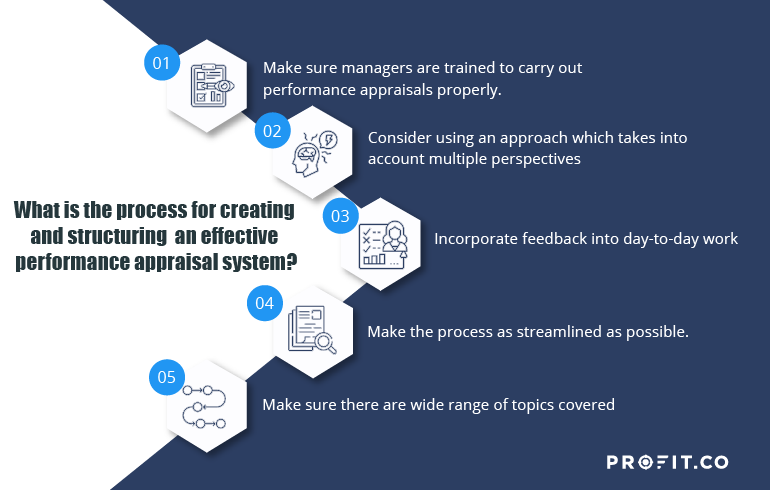If you’re in human resources, then you know having a well-established performance management system is invariably important for the wellbeing of your employees and your organization. It is an opportunity for the employee to meet with their manager and discuss how they have performed throughout the year.
What is performance appraisal?
Any systematic effort to measure and analyze an individual performance over a period of time based on relevant parameters constitutes a performance appraisal.
While styles will vary between organizations, most reviews will compare employee work and behavior alongside the expectations and objectives of the company.
The manager will provide feedback on the employee’s work and attitude while acknowledging significant achievements and identifying any areas of improvement.
Performance appraisals are an opportunity for the employee to recognize their successes and look forward to the year ahead.
They are also an opportunity for the organization to gather data that will help them to identify any common trends in performance (both good and bad), acknowledge and praise high performers, and implement development plans where they are needed.
What is an effective performance appraisal system?
The effectiveness of performance management systems will vary depending on what the organization does, the reviewed employee’s seniority level, and the set of objectives the employee has been asked to achieve for that year. It can also depend on how much time the organization, and those employed by it, dedicated to carrying out the appraisals.
Therefore, it can be difficult to implement a uniform appraisal system that will suit everyone.
However, regardless of the gritty details, a performance management system has to be fair, impartial, and well-structured.

What are the types of performance appraisal?
There is a wide range of different techniques used in carrying out appraisals. Companies can utilize various performance appraisal methods to suit their needs; however, three standout approaches exist.
3 modern techniques used are:
- 360-degree review system
- Straight ranking appraisals
- Employee self-assessment
1. 360-degree review system
To give you a clue…the definition is in the name!
This method involves asking for feedback on the employee from a number of different sources. For example, colleagues, clients or customers may all be asked to comment on the interaction they have had with that employee and how they found the experience. This information is gathered at different intervals throughout the year, giving a more holistic view of employee performance and experience
2. Straight ranking appraisals
This is the process of simply comparing all employees to one another, ranking them from best to worst using standardized criteria.
For example, if a department had an objective for each sales representative to make fifty sales for the quarter, employees would be ranked from best to worst– with the top sellers who made fifty sales or more at the top and the lowest sellers who didn’t meet their target at the bottom.
3. Employee 1 on 1 review
With this method, employees are asked to reflect on their own performance and evaluate themselves.
They are taking responsibility for their own improvement opportunities and performance successes. The employee’s self-assessment is usually then compared to the same assessment carried out by the employee’s manager, and any differences are reconciled in a one-on-one meeting.
One-on-one meetings are conducted by the managers at frequent intervals to listen to their direct reports regarding their progress in various aspects of work and understand how engaged they are. If you’re interested in leveraging the Profit.co software to efficiently schedule meetings, keep comprehensive notes, and track employee engagement, performance, and goals, schedule a free demo with our experts today!
Advantages and disadvantages of performance appraisal
360 Degree Review System
Advantages:
1. Unbiased view
By using this appraisal system, you are given a view of the employee that is shared by both internal and external stakeholders. It is more likely to give a true reflection of the behavior of the employee, as well as specific examples to support the evaluation.
2. Boosts confidence
A review that contains positive comments from peers can be incredibly encouraging for an employee. This model reinforces positive work habits and behavior.
3. Encourages regular feedback
Regular feedback throughout the year encourages a healthy work culture. This can lead to employees offering feedback and guidance to one another outside of their scheduled reviews.
Disadvantages:
1. The comments may come across as personal.
If an employee receives negative feedback from a colleague, it could greatly damage their confidence as well as ignite interpersonal tension in the office.
Straight ranking appraisals
Advantages:
1. Ease
Employees with the same job role are compared directly. On paper, managers can clearly see who has performed well against the objectives and who has not.
Disadvantages:
1. No middle ground
While this may identify the best and worst performers, this method does little to differentiate the employees whose performance falls between the very top and very bottom of the spectrum.
2. Too generalized
This method fails to take into account any personal or professional circumstances that may have had an impact on performance. This can damage the confidence and job satisfaction of employees who have a legitimate reason why their performance is not equal to that of their peers.
Employee self-assessment
Advantages:
1. Encourages self-reflection
Inviting employees to assess their own performance can be a useful practice. It encourages them to dissect their own behavior and evaluate their work habits.
Disadvantages:
1. Difficult
Employees often find it hard to assess themselves and to give themselves praise or critique.
2. Might cause tension
If a self-evaluation and manager evaluation are vastly different, it could cause tension. This makes it difficult to have a constructive performance appraisal meeting.
Which one of the three systems is the most effective?
Having considered the three different types of performance appraisal and their pros and cons, the 360-degree review system appears to be the most effective. This is unsurprising, given that Forbes stated that more than 85% of Fortune 500 companies use this method as their performance appraisal system.
No matter what type of performance appraisal you would like to initiate, Profit.co’s performance management module can help you evaluate employees effectively and efficiently. Try it free today!
What are the five steps in a performance appraisal?
1. Make sure managers are trained to carry out performance appraisals properly.
This cannot be overstated.
Managers need to understand why they are carrying out these reviews, how they are going to be used, and what they need to say to their employees. Managers should receive in-depth training on how to have difficult conversations and give constructive criticism
The impact of performance appraisals is business-wide and therefore the importance of it needs to be recognized by everyone involved in the process.
2. Consider using an approach like the 360-degree review, which takes into account numerous different opinions rather than only that of the manager
When both the employee and the manager have feedback from a number of individuals, it makes for an easier and more comprehensive performance review. It gives a much better picture of how that employee is viewed by colleagues and customers alike.
Whether that feedback is positive or negative, it is going to be an invaluable resource in supporting the outcome of the performance appraisal meeting.
3. Incorporate feedback into day-to-day work to make the review process less stressful.
Encourage employees to evaluate themselves and their colleagues throughout the year.
This will help them to come to their appraisal prepared for an open and honest discussion about their performance, as well as help them become more perceptive evaluators.
4. Make the process as streamlined as possible.
If continuous feedback is given throughout the year, the feedback an employee receives at their performance review meeting shouldn’t come as a surprise. Managers should let employees know the structure of their review so expectations are aligned.
Make sure that dates are set for the meetings, keeping to the same time each year if possible. Give employees plenty of notice of meetings so they have ample time to prepare.
5. When carrying out the appraisal process, make sure there are a number of topics covered such as:
- What went well
- What could have gone better
- Any specific needs that the employee has
- Goal setting for the year ahead
These topics help reveal employee strengths and notable skills as well as pitfalls and areas that need to be improved. It is also the employee’s opportunity to ask their manager if there are any reasonable adjustments they can implement to help make the manager’s role easier.
How is performance appraisal done?
The Do’s and Don’ts of implementing an appraisal system
Do’s:
- Choose a system and stick with it
Employees like consistency and want to know what to expect. It upsets the morale of the team when they feel like the “goalposts” are being moved. - If the organization chooses a performance appraisal system for that year, they should stick with it throughout the whole year, even if it does not feel right for the organization. Changing this system mid-year will mean employees do not know what is expected of them or what to expect from the organization and, worst-case scenario, they will leave.
- Make sure managers are properly trained on the appraisal process
Whatever performance appraisal system you use in your organization, make sure the managers carrying out the appraisal know what is expected of them and how they complete it properly. Provide ample training for managers, and place emphasis on how to give negative feedback in a constructive and motivating manner. While it’s human resources job to pick out the perfect review process, managers are the ones who have to make it work for their employees. - Make it a positive process :
Keep employees engaged in the process throughout the year and make sure that successes are celebrated. - Focus on achievements and look for development opportunities where appropriate. When employees feel valued and appreciated, they don’t look to leave and move somewhere else.
Don’ts:
- Don’t think that everyone is the same. Remember to take into account personal circumstances
- While it is important to have a robust system in place, it is equally important that the system allows all employees to be represented and treated fairly.
- There should be a way to account for any exceptional circumstances in the appraisal system you use, especially if that event affected the employee’s performance. This is especially important if it is something that they could not have helped or expected and is out of character for them.
Conclusion
Performance appraisals can be stressful for employees who are concerned about the outcome of the meeting and the impact it might have on their position within the organization.
That is why it is so important to create and implement a performance appraisal system, including performance management software, that is going to benefit both the employee and the organization, while being sensitive to the needs of employees.
Your work is going to fill a large part of your life, and the only way to be truly satisfied is to do what you believe is great work. And the only way to do great work is to love what you do.
If you help make the individuals in your company feel that they are valued and appreciated by the organization, they will be happy, productive, well-performing employees in return.
To learn how Profit.co can help you initiate quick and effective performance appraisals that tailor exactly to your teams’ needs, book a free demo with our experts today!

